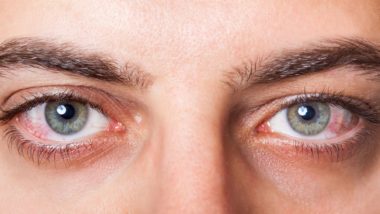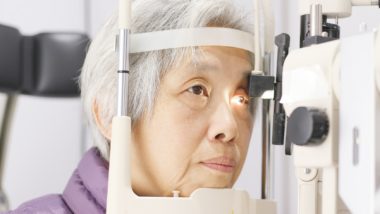Top Class Actions’s website and social media posts use affiliate links. If you make a purchase using such links, we may receive a commission, but it will not result in any additional charges to you. Please review our Affiliate Link Disclosure for more information.
Elmiron maculopathy is a type of eye disorder allegedly caused by long-term exposure to Elmiron, a drug used to treat the chronic bladder condition interstitial cystitis.
Maculopathy is a general term for eye disorders and issues that affect the macula, or the central part of the retina in the eye. The macula is the part of the retina responsible for sensitivity and visual acuity. Maculopathy often results in vision loss and blindness.
The type of eye damage associated with Elmiron is called pigmentary maculopathy. This type of eye disorder may present differently in different people, but symptoms generally include some or all of the following symptoms:
- Hyperpigmented dark spots on the retina
- Parafoveal pigmented deposits, or small blood vessels around the macula that become abnormal and result in vision loss
- Vitelliform deposits, or round, yellow lesions that form beneath the macula
- Retinal epithelium atrophy
From the sufferer’s perspective, symptoms affecting your vision to look out for can include seeing a dark spot when looking straight ahead, which then grows and expands over time. People may also notice distortion to objects in their vision, hallucinations, blurred vision, loss of color and contrast sensitivity, and difficulty readjusting after exposure to bright light. They may notice difficulty reading, or see that straight lines appear crooked or wavy.
The best method of detecting and diagnosing maculopathy early on is through regular eye examinations with an ophthalmologist—and to take notice of any changes to your vision as soon as possible—as macular degeneration is not curable.
What Causes Elmiron Maculopathy?
According to patient reports and research, exposure to Elmiron may result in vision loss and eye damage. Elmiron is prescribed to treat interstitial cystitis, a painful bladder syndrome. It’s the only drug approved by the U.S. Food and Drug Administration (FDA) for the treatment of interstitial cystitis.
Although the drug may be effective at managing the condition, it may also take months for patients to begin seeing results. Additionally, Elmiron is expensive and may result in several severe side effects.
According to a 2018 article published by the American Academy of Ophthalmology, six patients who were treated at the Emory Eye Center between 2015 and 2017 experienced pigmentary maculopathy after long-term exposure to Elmiron. The report was later updated to include four more patients who experienced the same side effects. Additionally, between 1997 and 2019, 100 cases of Elmiron-related eye disorders were reported to the FDA.
Besides Elmiron maculopathy, WebMD reports that the drug may also result in a slew of side effects, including:
- Alopecia
- Bruising
- Diarrhea
- Gastroesophageal reflux
- Headaches
- Skin rash
- Sleeping trouble
- Unusual bruising or bleeding
- Mental and mood changes
- Heartburn
While a number of these side effects are on the drug’s label, Elmiron’s product labeling does not include a warning about pigmentary maculopathy. People who have suffered from vision loss or blindness caused by the drug may be able to file a lawsuit against the manufacturer for failing to disclose the possible side effects.
What is Interstitial Cystitis?
Interstitial cystitis, also known as bladder pain syndrome, causes pain and pressure in the bladder and abdomen without an apparent cause, like a UTI. Pain may vary from mild to severe and could be triggered by things such as menstruation, sitting for a long period of time, exercise, stress, and sexual activity. In some people, according to the Mayo Clinic, pain may be accompanied by the persistent need to urinate or frequent urination in small amounts.
The cause of interstitial cystitis is not well understood; however, many factors likely contribute to a person developing the condition. For example, the protective lining of the epithelium may be affected by a defect in affected patients. A leak in this protective lining may allow the bladder wall to be irritated by toxic substances filtered out of the body by the kidneys.
The Mayo Clinic states that irregular urination may also be related to a neurological issue. In a healthy patient, the bladder expands until it is full and then signals the need to urinate through the pelvic nerves to the brain. It is theorized that these connections may be affected by interstitial cystitis.
Other theories suggest that interstitial cystitis may be caused by autoimmune issues, heredity, infection, or allergies.
Although it is not known exactly how Elmiron works to treat interstitial cystitis, the drug is theorized to work by coating the wall of the bladder and protecting the organ from being irritated. It may take two to four months for the drug to help with pain-related symptoms and up to six months for Elmiron to help with irregular urination.
Unfortunately, although Elmiron is one of the only options to treat interstitial cystitis, the drug may lead to maculopathy. The only other treatment options include physical therapy, or more drastic measures such as nerve stimulation, bladder distention, bladder instillation medications, and surgery.
Filing an Elmiron Lawsuit
A growing number of patients are coming forward with lawsuits alleging that the use of Elmiron has caused serious side effects, including maculopathy and vision problems. According to lawsuits, Elmiron was intended for long-term use—but it is with the long-term use of the drug that patients face an increased risk of suffering from complications.
For example, a Texas woman recently took legal action against Elmiron manufacturer Janssen Pharmaceuticals. According to the plaintiff’s lawsuit, her interstitial cystitis has been treated with Elmiron since 1997. In 2002, the woman began to develop maculopathy and, by 2010, she was declared legally blind, according to her allegations. Although her eye problems continue to stack up, the plaintiff says she only recently learned that her legal blindness could be linked to Elmiron.
Those who have developed maculopathy after long-term exposure to Elmiron may be able to hire an attorney and pursue compensation for injuries, medical expenses, pain and suffering, disability, and other damages. Filing a lawsuit cannot take away the pain and suffering caused by these vision problems, but it can at least help to alleviate the financial burden.
Filing a lawsuit can be a daunting prospect, especially while dealing with these kinds of injuries, so Top Class Actions has laid the groundwork for you by connecting you with an experienced attorney. Consulting an attorney can help you determine if you have a claim, navigate the complexities of litigation, and maximize your potential compensation.
Join an Elmiron Side Effects Lawsuit Investigation
If you took Elmiron and developed pigmentary maculopathy, you may qualify to participate in an Elmiron side effects lawsuit investigation.
Fill out the form on this page for a FREE case evaluation.
ATTORNEY ADVERTISING
Top Class Actions is a Proud Member of the American Bar Association
LEGAL INFORMATION IS NOT LEGAL ADVICE
Top Class Actions Legal Statement
©2008 – 2024 Top Class Actions® LLC
Various Trademarks held by their respective owners
This website is not intended for viewing or usage by European Union citizens.
Get Help – It’s Free
Join a Free Elmiron Lawsuit Investigation
If you qualify, an attorney will contact you to discuss the details of your potential case at no charge to you.
PLEASE NOTE: If you want to participate in this investigation, it is imperative that you reply to the law firm if they call or email you. Failing to do so may result in you not getting signed up as a client or getting you dropped as a client.
E-mail any problems with this form to:
Questions@TopClassActions.com.
Oops! We could not locate your form.














